The Overgeneration Problem in California
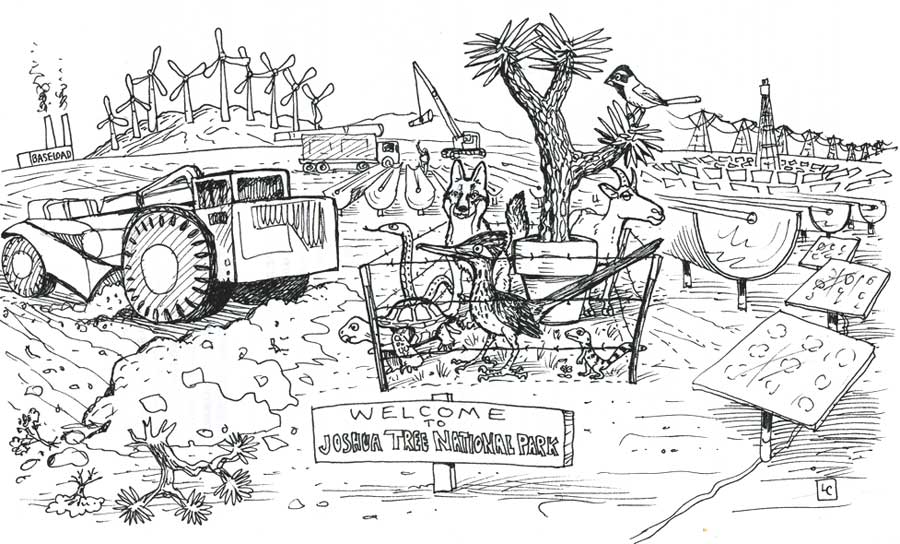
June 22, 2017 - Finally catching up to our analysis, the Los Angeles Times has a good article out about the glut of solar now in the Golden State, and how electricity generation from large-scale solar projects in the desert must be curtailed more and more.
They discuss the findings of former San Diego Gas and Electric engineer Jaleh Firooz:
Firooz reported that "...a combination of improved energy efficiency, local solar production, storage and other planning strategies would be more than sufficient to handle the area’s power needs even as the population grew."
No need for more utility-scale solar projects to be built on desert ecosystems.
We have been talking about this for a year now, based on meetings of the Renewable Energy Action Team, and such information shared below. This is precisely where Distributed options like Community Choice Aggregates and residential solar paired with advanced battery storage can help store some of the glut so it does not unbalance the grid. But this requires a new utility model, and that has been somewhat slow and painful for California.
Non-Transmission Alternative: DRECP Is Outdated
"Distributed generation and distributed storage could be a total game changer..." (WAPA)

Old Models Vs. New Models
By Laura Cunningham
September 13, 2016 - Do we really need the DRECP? That's the huge bureaucratic development plan for our beloved California Desert, the Desert Renewable Energy Conservation Plan. The more we hear about the gargantuan plans to get California to its renewable energy goals under the old utility-scale models, the more we support energy efficiency and Distributed Energy Resources. The transmission component alone of these plans will be very costly and take years to fully build out, carving new swaths of disturbance and roads through the desert wildlands.
The California Independent System Operator (CaISO), California Energy Commission (CEC), and California Public Utilities Commission (CPUC) also revealed that California now has so much utility-scale solar that the state is over-generating in peak times. The DRECP may not be needed because of this trend alone: we need to slow down and integrate more energy efficiency and distributed storage into the California grid to shift peak use.
The California Independant System Operator explains this over-generation problem: http://www.caiso.com/Documents/FlexibleResourcesHelpRenewables_FastFacts.pdf
The National Renewable Energy Laboratory (NREL) reported that California has filled all its high quality wind resources areas with wind projects (San Gorgonio Pass, Tehachapi Pass, Altamount Pass, for example), so now what is needed are lower cost wind projects in distant Wyoming-Colorado-New Mexico high quality wind areas. Which we still oppose due to the great potential of Distributed Generation locally which remains untapped.
So why are we planning for solar and wind in the California Desert?
Old Models: Transmission Planning Across the Western States
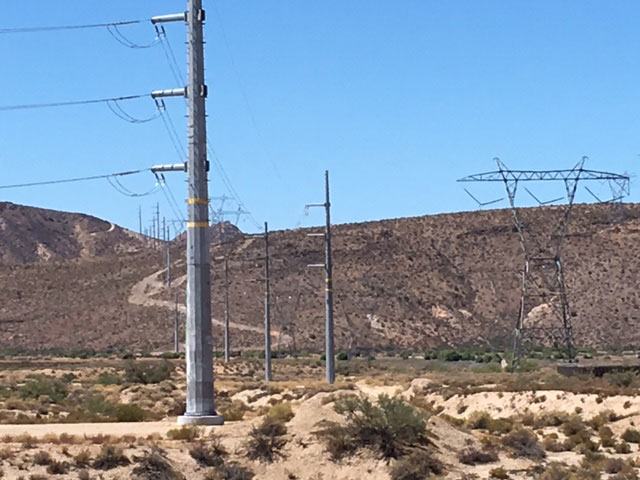
^Sunrise Powerlink at Jacumba Substation is eastern San Diego County CA.
Because California is stubbornly holding onto utility-scale models of energy generation and consumption, despite being a renewable energy leader. But the time has come when those expensive models are being pushed to their breaking point. We must consider new models.
On September 1, 2016 we participated in a RETI 2.0 "scoping and envisioning proces," in Las Vegas NV (slides here). This has been a long planning process to bring huge new transmission projects across the western states, mostly trying to bring energy to California coastal cities from distant sources.
California Governor Brown signed an Executive Order in 2015 to reduce greenhouse gases 40% below 1990 levels by 2030. He said the state needed transmission grid developments across the western US to meet these goals. This version of the Renewable Energy Transmission Initiative is based on older models--it was admitted there are no new models--existing studies are being leveraged.
The Old Model runs like this: Renewable energy planning in California is focused on the Desert Renewable Energy Conservation Plan (DRECP) and in San Joaquin Valley. Nevada can supply California with renewable generation, western Nevada has geothermal energy. Colorado, Wyoming, and New Mexico have a lot of "high quality" wind resources that can supply California. Somehow build giant and expensive transmission lines stretching hundreds of miles across mountain ranges, through towns, and across wild natural landscapes, all converging on load centers in California. Ratepayers will pay for these transmission lines through utility capital recovery rate hikes. It will take years to permit and construct this multi-state mega-grid.
But is this really needed?
Over-generation of Solar Now
Not making the news widely is the observation that California utility-scale solar projects are now over-generating energy during peak hours. California now actually needs more baseload, storage, or other kinds of renewable energy--such as wind--that run during the night or off-peak times.
But there are problems with getting baseload geothermal energy from western Nevada to California: the giant wall of the Sierra Nevada. There are transmission restrictions getting over the Sierras.
NV Energy, the main utility in Nevada, also reported it has to curtail solar projects during peak times as well, and this is a problem. Nevada has reached and now exceeds its Renewable Portfolio Standard, according to the Nevada Governor's Office, and NV Energy is seeking ways to export excess solar energy or reduce imports (see below). But California is also over-generating at peak times so exporting Nevada solar to California is not the solution. California and Nevada large-scale solar projects are over-generating at the same time.
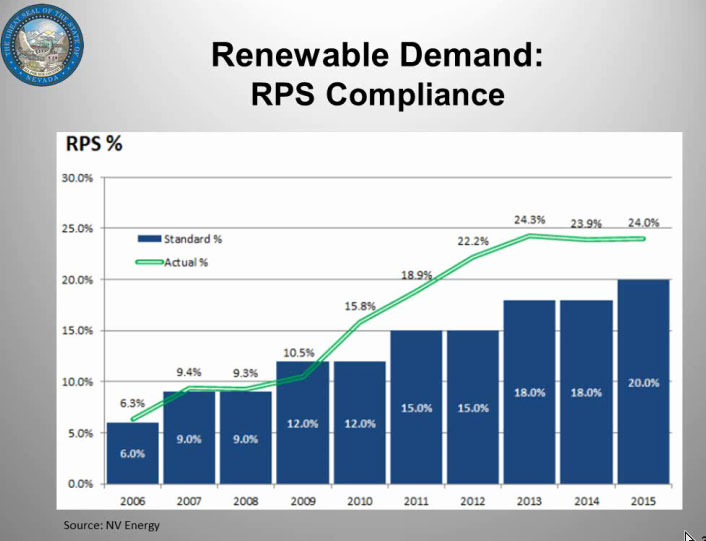
^Nevada RPS and actual renewable energy generation.
New Models
Distributed battery storage paired with rooftop solar systems could offer peak load shaving. Net metering generators could be paid for the amount of solar energy they store, instead of selling excess back to the grid. Dispatchable technologies could be investigated in this distributed approach, instead of spending billions of dollars on new thousand-mile-long transmission lines. There are new models worth investigating to avoid giant land use costs of utility-scale solar and wind projects. And of course energy conservation and efficiency can help ease peak over-generation. Why are we not truly smart from the start?
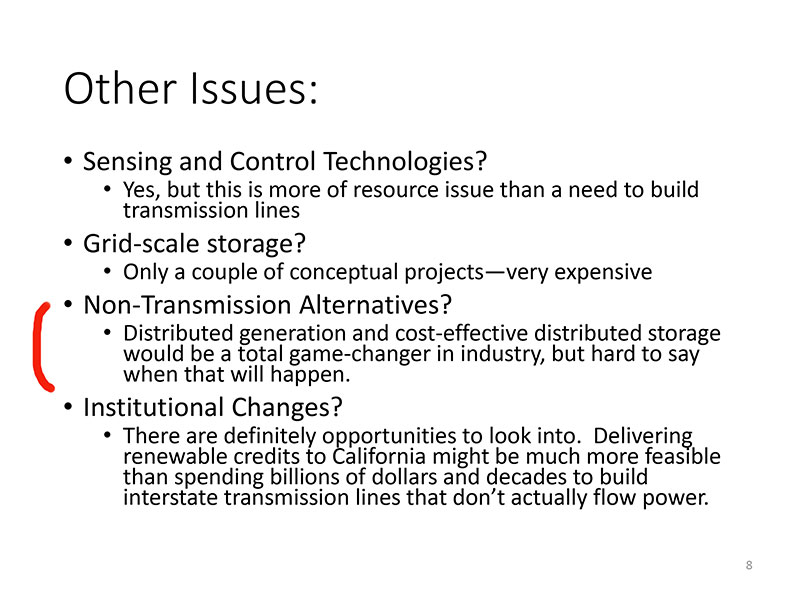
^Patrick Harwood gave a presentation at the RETI 2.0 meeting in Las Vegas for the Western Area Power Administration (WAPA), saying that distributed generation could be a game-changer (if policy obstacles are lifted).
This New Model isn't just an idea. Southern California Edison (SCE) is running a real-world pilot program in Orange County CA to build 125 MW of distributed energy storage and demand response. Load management technologies paired with distributed residential battery systems will help an area prone to grid imbalances and shortages--just the type of problems that California agencies worry could happen on a wider scale due to utility-scale solar and wind imbalances on the grid.
"This patch of grid is a hot spot for future power shortages and imbalances, caused by the closure of the San Onofre nuclear power plant, the coming closures of natural-gas-fired power plants serving the area, and the changing patterns of grid power generation over the course of the day, largely driven by the growth of rooftop solar PV" (Jeff St. John: Greentech Media).
Why isn't this important renewable energy advance making the mainstream news? Large-scale desert renewable energy projects are flashy and noticeable, but it's the small, local renewable energy generation that may in fact add larger services to the grid. And avoid destroying desert ecosystems.
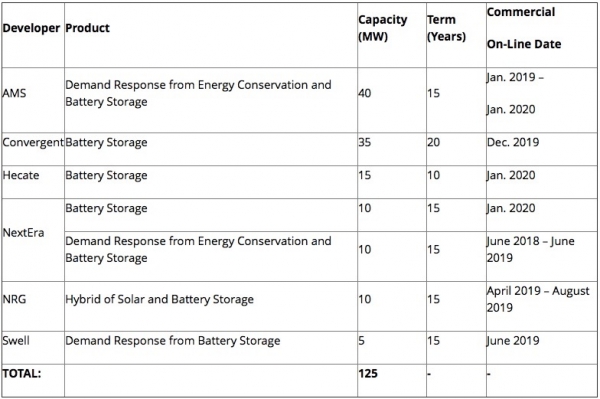
^SCE schedule for implementing Distributed Energy Resources in Orange County CA (Greentech Media). What if all of California implemented such a program? We wouldn't need a gigantic western grid build-out.
But California Big Energy Planners Want High Quality Wind
Meanwhile, under the Old Model, distance is the obstacle--distance from the best renewable energy resources to load centers. There is a potential for repurposing transmission lines as coal power plants are retired in the future: the Navajo plant in 2019 (-750 MW); San Juan in 2017 (-837 MW); Cholla in 2015 (-260); Four Corners in 2015 (-560 MW), and others. Coal power plant retirement in Four Corners would be closer to Colorado wind resources and that existing transmission could be used to funnel wind energy through the El Dorado Substation to California cities. But long interconnection lines would still be needed to reach the wind resources in the Plains.
Newer technologies could result in even larger wind turbine generators to collect wind energy: higher towers, larger blades.
What was also revealed about the lack of need for a DRECP is that all the high quality wind resources within California have been filled with wind projects. Now only the poorer wind areas are left, so utilities are seeking better wind resources. And those are distant, out in Wyoming, Colorado, and New Mexico on the wind-swept Great Plains. High quality wind means lower costs to generate energy from turbines. NREL reported that wind energy is at a higher cost now in low wind areas of the Western US, close to and within California.
The RETI 2.0 Plenary Report says, of wind:
"The natural availability of renewable energy across the West is widespread, especially for wind and solar. There is wide geographic diversity in the availability of renewable energy. Oregon and Washington are major resources for hydroelectric (hydro), wind, and biomass. High-value solar is readily available in Arizona and Nevada, and wind potential is vast in eastern Wyoming and New Mexico. Geothermal is available throughout central and northern Nevada and southern Oregon.
"The abundant natural availability of wind in Wyoming, New Mexico, and, to a slightly lesser extent, Idaho and Oregon translates into relatively low costs for the renewable energy generated in those regions. Because wind in these areas is less intermittent than in other areas, wind turbines in these areas will have a high capacity factor (more than 40 percent), and this directly translates to relatively low costs for the wind energy."
Cost of Large Transmission

At the RETI 2.0 meeting, several transmission project proponents presented their plans for constructing long transmission line segments to try to connect future wind projects in eastern Wyoming, Colorado, and New Mexico, to load centers like Los Anegeles and San Diego on the California Coast. The price tags were large.
--Zephyr project by Pathfinder would be a 500 kiloVolt (kV) transmission line with a 2,000-3,000 MW cap, from Wyoming wind areas to the El Dorado Substation in southern Nevada (to connect to California):
Price: $3 Billion.
--SunZia line would cross 515 miles from wind areas in New Mexico to California, two 500 kV AC projects, 3,000 MW transfer:
Price: $2 Billion.
--Clean Line from wind resources on the Plains of New Mexico to southern California, 5 different segments to connect wind projects east and west. Centennial West transmission line would be 900 miles. Just one segment, the Western Spirit segment within New Mexico would cost:
Price: $150 Million
And there were other competing proposals that did not give estimated costs, such as the Southline Transmission Project. Line losses of energy were also mentioned.
TransWest Express transmission project was just approved in December 2016.
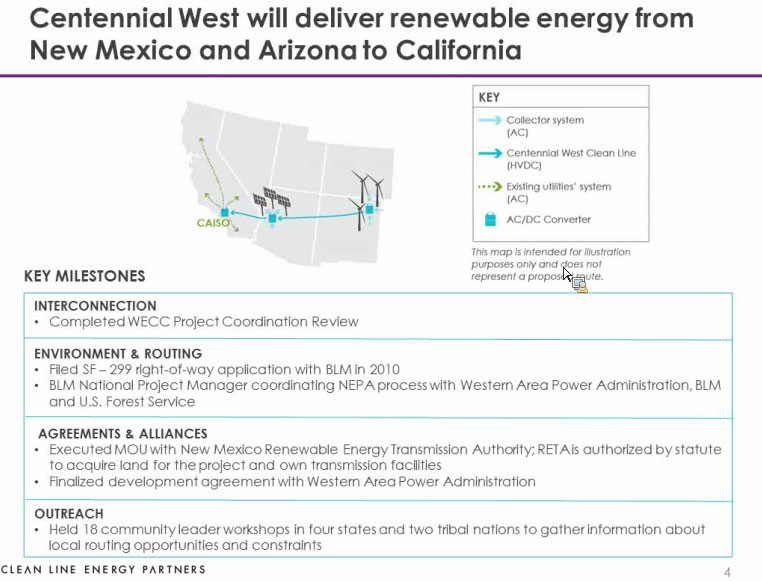
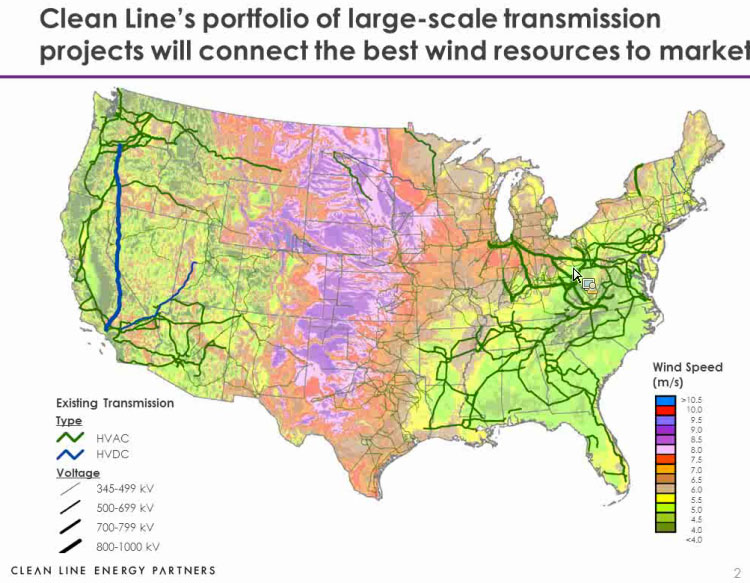
Southwest Powerlink Plans
While the large-scale renewable industry decries the DRECP's locking up of land that they want for instate desert solar and wind projects, utilities are quietly planning for renewable energy outside of the state--what they need now under their Old Model.
San Diego Gas & Electric and Sempra Energy want to re-engineer the Southwest Powerlink transmssion line through Imperial Valley CA so it can handle distant wind energy from Plains states, awaiting other transmission proposals to hook into the line through Arizona. The Southwest Powerlink would be converted to a multi-terminal, multi-polar HVDC system, accomodating 3,000 MW. New converter stations would be built at Miguel and North Gila. They admit that renewable energy built in the California region nearby would actually be more costly, so the desire is to obtain cheaper wind energy from Arizona, New Mexico, and Mexico.
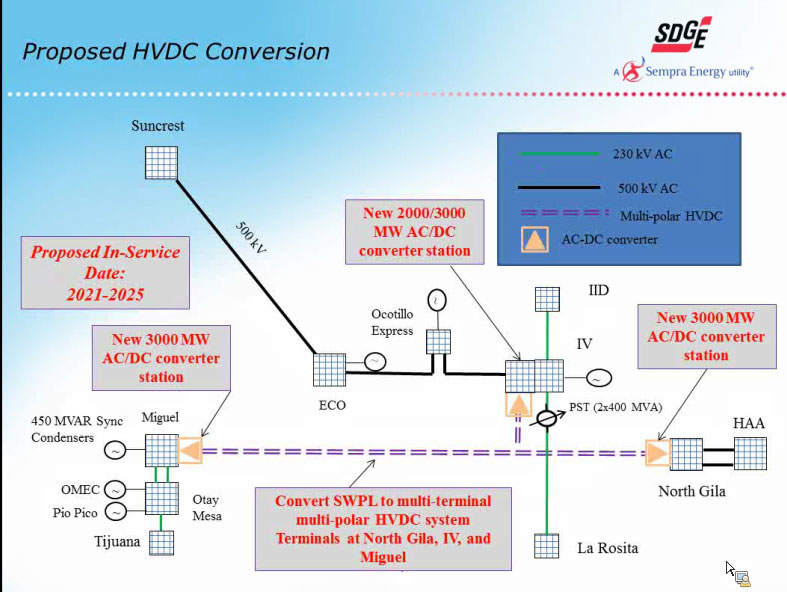
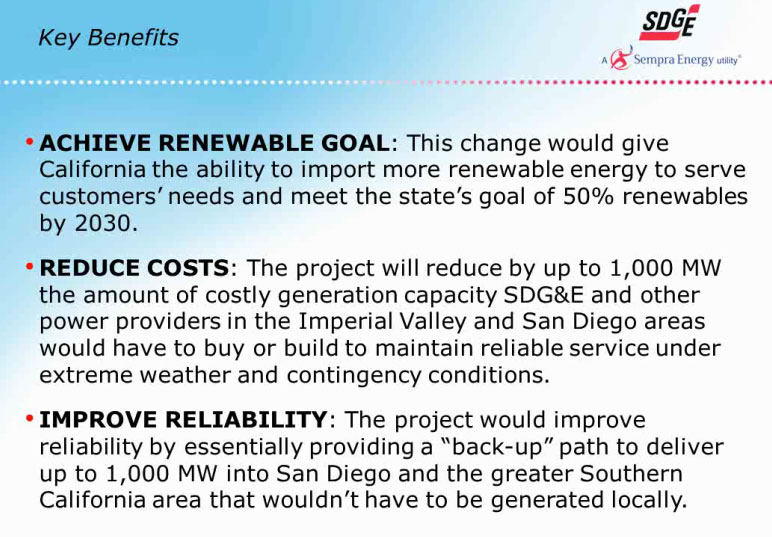
Public Land Planning for Transmission Corridors
The Bureau of Land Management told the meeting attendees that the DRECP did not address corridors, and this placed constraints on renewable energy developers. Soon there will be land use plan recommendations to add, alter, or delete corridors (will transmission corridors be added to National Conservation Areas designated in the DRECP?).
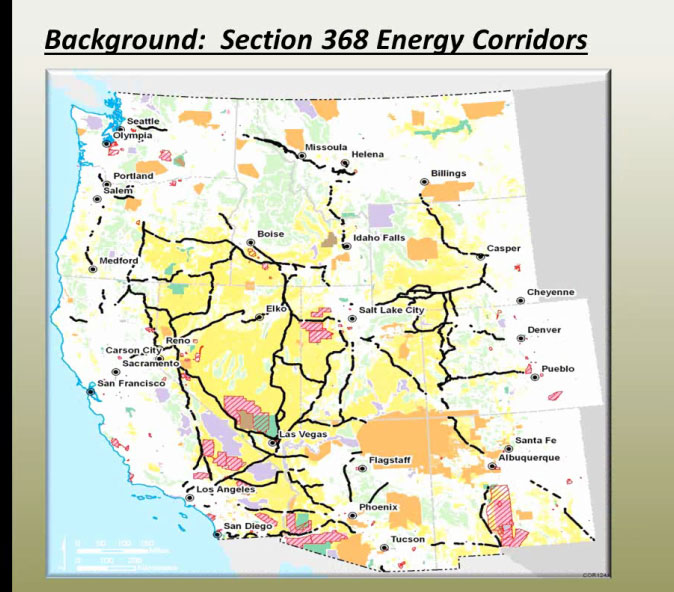
^Transmission corridors across the western US.
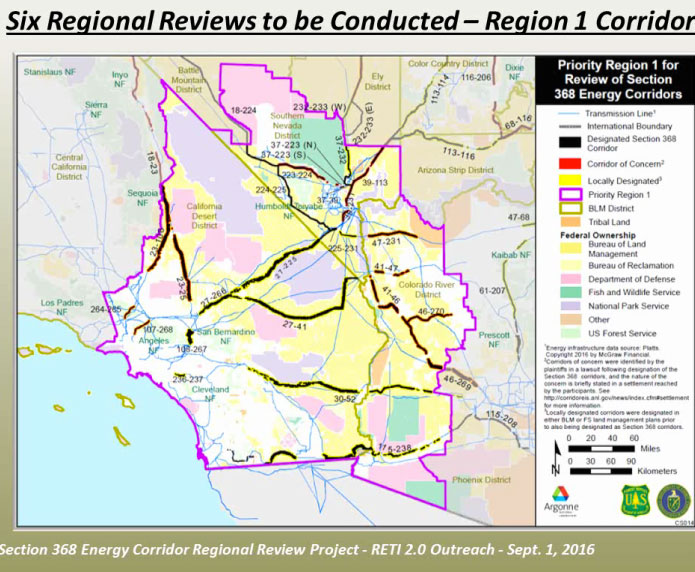
The DRECP is Outdated
The bottom line is this: California energy agencies admit that energy efficiency and rooftop solar are critical to meeting the state's RPS (see below). We have enough desert solar and wind, we now need to plan for better integration of renewable energy, storage, demand response, peak shaving, and other variables that the renewable energy rush onto public lands has bypassed.
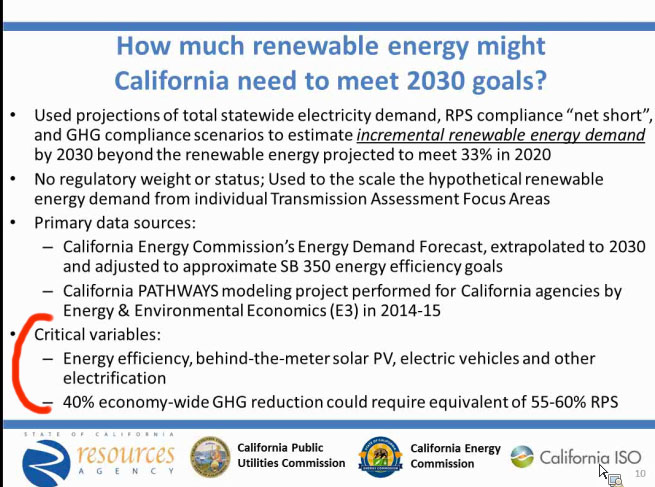
During this RETI 2.0 meeting we heard interesting hints that Non-Transmission Renewable Energy Alternatives should be explored and implemented: Distributed Energy Resources and energy efficiency. Distributed generation could be a game-changer.
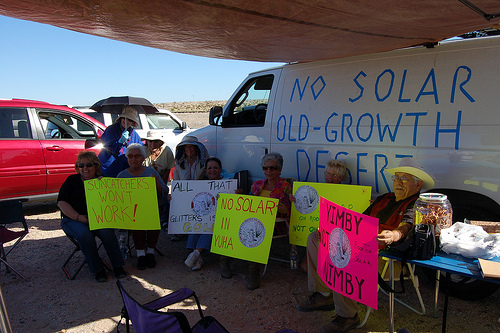
HOME.....Distributed Energy Resources Alternative.....Energy Efficiency Alternative
More on Renewable Energy Transmission Initiative 2.0 (RETI)....Transmission
